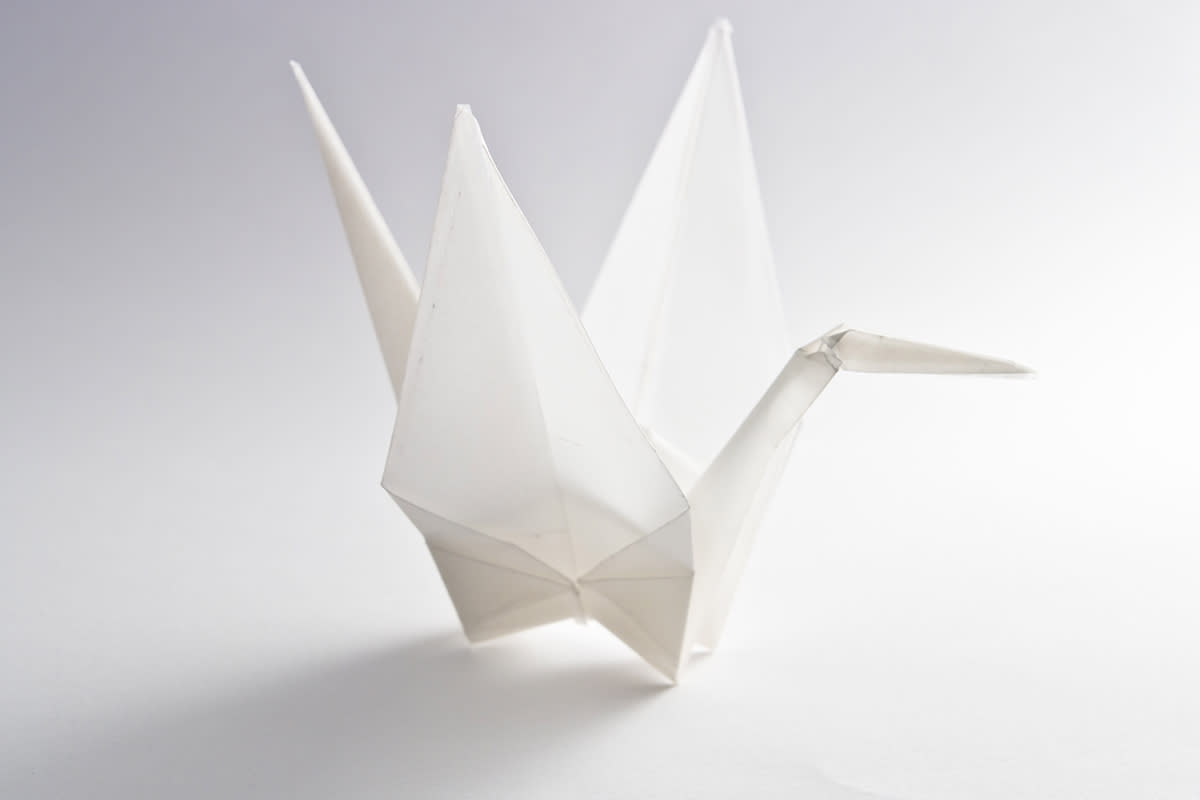The future of ovarian cancer treatment might be found in origami

Katerina Mantzavinou is looking to revolutionize cancer treatment, one origami shape at a time.
The PhD student at the Harvard—MIT Program of Health Sciences and Technology made her debut in a video on medical news site STAT this month, discussing how the ancient art of paper folding inspired the design of a new drug delivery structure — one that could transform treatment for ovarian cancer.
The story dates back to the spring of 2013, when Mantzavinou joined a team of researchers at the Koch Institute for Integrative Cancer Research who were working on finding alternate treatment methods for ovarian cancer. Traditionally, patients with ovarian cancer — specifically those for whom the cancer has spread — receive chemotherapy treatment through an indwelling (inside the body) catheter. This can prove incredibly painful and difficult to sustain over the long term.
This particular team wanted to figure out a better way to deliver these important drugs. Their idea was to surgically implant something, using laparoscopic surgery, that could carry the drugs. They key question the team asked themselves was this: How can we create something small enough to be implanted through a trocar (a surgical device used in laparoscopic surgery) but big enough to distribute chemotherapy drugs to a large surface area in the abdomen?
When Mantzavinou arrived, the team was rallying around the idea of using a long, thin device as their means of drug distribution. “Their vision was tubular — like a spaghetti straw,” she says of the initial structure. “But we knew from the get-go that there would be limitations there.” Among the concerns with a spaghetti-like implant was that it would get tangled in the abdomen, possibly wrapping around one of the patient’s organs.
As Mantzavinou brainstormed a better design, she remembered her undergraduate thesis in engineering from Harvard. For that assignment, she was tasked with creating a patch to cover a hole in a baby’s diaphragm that would grow with the baby. “We had tried to use origami as a way to slowly unfold tissue,” she tells Yahoo Lifestyle. “So I did a lot of work on origami there.”
In that instance, Mantzavinou had used origami to cover something small that would eventually grow larger. This time, she was looking for the opposite effect. “We were trying to combat the tiny diameter [of the incision],” Mantzavinou tells Yahoo Lifestyle. “The idea is that it will expand into bigger dimensions than what the incision would allow. It will become something bigger inside the body.”
Mantzavinou decided to test her origami theory, so she went to local arts and craft store, scooped up a bunch of paper, and started folding. Mantzavinou says the origami was never meant to be implanted in the body. Instead it’s a “proof of concept” — an object that, through repetitive folds, is dramatically reduced in size.
Based on this repetitive fold pattern, she created a mold through a 3D printer. This mold can then be filled with silicone (similar to the type used in breast implants) to make the final product: a biocompatible structure that can fit through a trocar, then expand once in the body, delivering drugs to the places where the cancer has spread.
Since some of Mantzavinou’s plan is, as she refers to it, “ongoing science,” there are certain details that can’t be shared. It’s unclear exactly what shape, for example, the structure would take inside the body, or how long it would stay there. But given how hard her team is working, it seems likely that those answers are on their way. At the moment, the deployable structure is being tested in mice — where it is already showing promising results.
“It’s a really complex puzzle,” Mantzavinou tells Yahoo Lifestyle. “These kinds of technologies have a lot of moving parts. [Chemotherapy] is a toxic drug, and it’s extremely unsafe if something goes wrong, so there’s a lot that has to be done to make sure that things are working the way we want them to.”
Despite what her idea may suggest, Mantzavinou never got into origami as a hobby. “I might have built one crane before,” she says. A native of Athens, Greece, she moved to the U.S. for college a decade ago and has been here ever since. Now she’s working around the clock to help save lives.
Although the origami-inspired structure isn’t yet ready for use in humans, the idea alone could inspire hope in the 22,000 women diagnosed with ovarian cancer each year. As the deadliest of the gynecological cancers, ovarian cancer is notoriously difficult to catch early. When doctors locate it before it has spread past the ovaries, the five-year survival rate is 92 percent. But unfortunately, this only happens 20 percent of the time.
For most women, a diagnosis of ovarian cancer comes with the news that it has already spread — and that it is essential to quickly start the delivery of chemotherapy through a catheter. It’s the discomfort that comes with this treatment option that Mantzavinou is hoping to bypass. “The fundamental idea for the project was moving away from giving the patient bursts of chemotherapy once every two weeks in their belly,” she says. “Instead, we would put in an implant that does this over time, at a lower dose.”
If successful in treating ovarian cancer, Mantzavinou’s origami model could have far-reaching effects. “Drug delivery in that place in the body could be very promising,” Mantzavinou tells Yahoo Lifestyle. “It has implications for all kinds [of diseases]— GI cancer, lung cancers, other gynecological cancers, and even things that are noncancerous. So this is very much thinking about the future. There’s a lot of promise.”
Read more from Yahoo Lifestyle:
Christina Applegate had her ovaries, fallopian tubes removed
This newly approved drug treats breast cancer like Angelina Jolie’s
Follow us on Instagram, Facebook, and Twitter for nonstop inspiration delivered fresh to your feed, every day.
